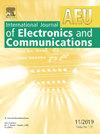展示了金属填充SSPP在高性能功率放大器先进输出匹配网络中的优越性
IF 3.2
3区 计算机科学
Q2 ENGINEERING, ELECTRICAL & ELECTRONIC
Aeu-International Journal of Electronics and Communications
Pub Date : 2025-08-28
DOI:10.1016/j.aeue.2025.156016
引用次数: 0
摘要
本文设计并优化了一种利用欺骗表面等离子激元(SSPPs)在2.4 GHz频率下的高效功率放大器(PA),以增强微波应用中的阻抗匹配。利用表面等离子体激元(SPPs)在微波域中模拟了电磁波与金属介质界面上自由电子相互作用产生的表面等离子体激元(SPPs)。这些结构可以实现强场约束、紧凑性和改进的信号完整性。然而,在更小的空间内有效地放大高功率等离子体信号仍然是一个关键的挑战。为了解决这个问题,氮化镓(GaN) HEMT技术被采用。三个SSPP线集成到输出匹配网络(OMN)中,其中结构修改:空气填充和金属填充孔,被引入。对比测量结果表明,经典放大器的输出功率为38.99 dBm,增益为13 dB,效率为53.7%,相邻通道功率比(ACPR)为-68 dBc, C/I为25.5 dBc。加入充气孔后,输出功率和效率分别提高了7.14%和4.26%。金属填充孔径进一步提高了输出功率13.71%和效率13.83%,ACPR和载流子干扰比(C/I)分别提高了5.88%和17.65%。这些结果证实了基于sspp的omn在紧凑型无线前端的可扩展、高性能基于gan的pa中的实用性。本文章由计算机程序翻译,如有差异,请以英文原文为准。
Exhibiting the superiority of metal-filled SSPP in advanced output matching networks for high-performance power amplifier
This paper presents the design and optimization of a high-efficiency power amplifier (PA) utilizing spoof surface plasmon polaritons (SSPPs) at 2.4 GHz for enhanced impedance matching in microwave applications. Surface plasmon polaritons (SPPs), arising from the interaction between electromagnetic waves and free electrons at the metal–dielectric interface, are emulated in the microwave domain using SSPPs. These structures enable strong field confinement, compactness, and improved signal integrity. However, efficient amplification of high-power plasmonic signals in a reduced footprint remains a key challenge. To address this, Gallium Nitride (GaN) HEMT technology is employed. Three SSPP lines are integrated into the output matching network (OMN), where structural modifications: air-filled and metal-filled apertures, are introduced. Comparative measurements indicate that the classical PA achieved 38.99 dBm output power, 13 dB gain, 53.7% efficiency, -68 dBc adjacent channel power ratio (ACPR), and 25.5 dBc . Incorporating air-filled apertures led to 7.14% and 4.26% improvements in output power and efficiency, respectively. Metal-filled apertures further enhanced output power by 13.71% and efficiency by 13.83%, while improving ACPR and carrier-to-interference ratio () by 5.88% and 17.65%, respectively. These results confirm the utility of SSPP-based OMNs in scalable, high-performance GaN-based PAs for compact wireless front-ends.
求助全文
通过发布文献求助,成功后即可免费获取论文全文。
去求助
来源期刊
CiteScore
6.90
自引率
18.80%
发文量
292
审稿时长
4.9 months
期刊介绍:
AEÜ is an international scientific journal which publishes both original works and invited tutorials. The journal''s scope covers all aspects of theory and design of circuits, systems and devices for electronics, signal processing, and communication, including:
signal and system theory, digital signal processing
network theory and circuit design
information theory, communication theory and techniques, modulation, source and channel coding
switching theory and techniques, communication protocols
optical communications
microwave theory and techniques, radar, sonar
antennas, wave propagation
AEÜ publishes full papers and letters with very short turn around time but a high standard review process. Review cycles are typically finished within twelve weeks by application of modern electronic communication facilities.

 求助内容:
求助内容: 应助结果提醒方式:
应助结果提醒方式:


